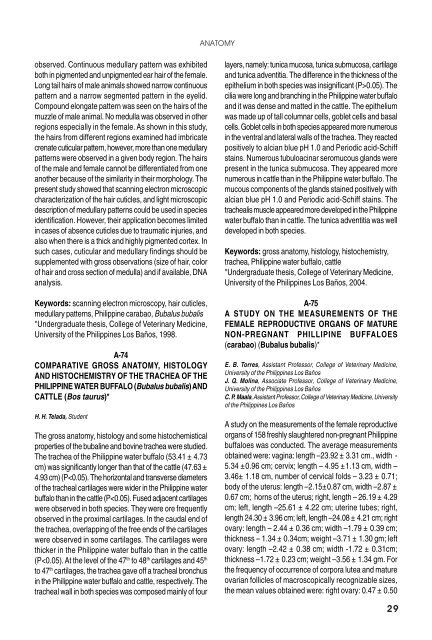THE PHILIPPINE WATER BUFFALO
THE PHILIPPINE WATER BUFFALO
THE PHILIPPINE WATER BUFFALO
You also want an ePaper? Increase the reach of your titles
YUMPU automatically turns print PDFs into web optimized ePapers that Google loves.
observed. Continuous medullary pattern was exhibited<br />
both in pigmented and unpigmented ear hair of the female.<br />
Long tail hairs of male animals showed narrow continuous<br />
pattern and a narrow segmented pattern in the eyelid.<br />
Compound elongate pattern was seen on the hairs of the<br />
muzzle of male animal. No medulla was observed in other<br />
regions especially in the female. As shown in this study,<br />
the hairs from different regions examined had imbricate<br />
crenate cuticular pattern, however, more than one medullary<br />
patterns were observed in a given body region. The hairs<br />
of the male and female cannot be differentiated from one<br />
another because of the similarity in their morphology. The<br />
present study showed that scanning electron microscopic<br />
characterization of the hair cuticles, and light microscopic<br />
description of medullary patterns could be used in species<br />
identification. However, their application becomes limited<br />
in cases of absence cuticles due to traumatic injuries, and<br />
also when there is a thick and highly pigmented cortex. In<br />
such cases, cuticular and medullary findings should be<br />
supplemented with gross observations (size of hair, color<br />
of hair and cross section of medulla) and if available, DNA<br />
analysis.<br />
Keywords: scanning electron microscopy, hair cuticles,<br />
medullary patterns, Philippine carabao, Bubalus bubalis<br />
*Undergraduate thesis, College of Veterinary Medicine,<br />
University of the Philippines Los Baños, 1998.<br />
A-74<br />
COMPARATIVE GROSS ANATOMY, HISTOLOGY<br />
AND HISTOCHEMISTRY OF <strong>THE</strong> TRACHEA OF <strong>THE</strong><br />
<strong>PHILIPPINE</strong> <strong>WATER</strong> <strong>BUFFALO</strong> (Bubalus bubalis) AND<br />
CATTLE (Bos taurus)*<br />
H. H. Telada, Student<br />
The gross anatomy, histology and some histochemistical<br />
properties of the bubaline and bovine trachea were studied.<br />
The trachea of the Philippine water buffalo (53.41 ± 4.73<br />
cm) was significantly longer than that of the cattle (47.63 ±<br />
4.93 cm) (P


